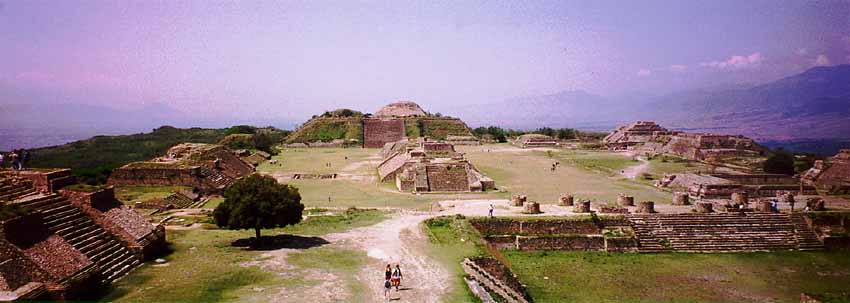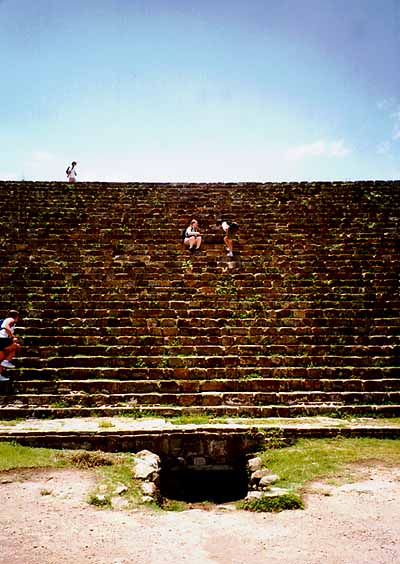 |
Monte Alban is a hill-top site, centrally
located within the valley of Oaxaca. It controlled much of the modern state
of Oaxaca during the Classic Period of Mesoamerican prehistory. The view
seen here is from the North Platform. Click on this photograph and follow
the links to other views of the site and of the valley. |
 |
The ancient Zapotec civilization of the Valley of Oaxaca is famous
for their subteranean tombs. Here you'll find two photographs of Tomb 104. The first is a ceramic statue depicting a seated
person wearing the headdress of Cocijo, a major Zapotec diety. He sits in
a niche above the entrace to tomb 104. The photograph which follows is of
the interior of Tomb 104. The beautiful polychrome murals which adorn its
walls are still visible today, though difficult to photograph using only
the reflected sunlight from above. |
 |
The Ball Court at Monte Alban is in
the shape of a capital "I", and possesses no rings. However, it
does possess a central stone marker which may have been used to bounce the
ball at the beginning of a game (which Ignacio Bernal points out is the
way Zapotecs begin a different ball game today). There are also four niches
in the corners of the court which served an unknown function. |
 |
The North Platform rests upon a natural
rise in the bedrock. This monumental staircase leads to other structures
located on top of the North Platform. A tall monument rests at the foot
of this staircase, with carvings on all four visible sides. To the East
of the staircase is a small chamber with a carved lintel and another carving
inside. |
 |
A labyrinth of tunnels criss-cross beneath
the central plaza. Some lead to the other side of a building, others lead
to the other side of the site. Here, one such tunnel is visible in the foreground,
and two visitors peer into a chamber within this structure. Inside the chamber
is a small opening which allowed light to enter from a hole in the platform
above. This tube of light may have been used to map the passage of the sun
across the sky at different seasons. |
 |
Monte Alban had its beginnings in the Formative Period of Mesoamerican
prehistory. Many of the most famous monuments
were carved at that time. However, most of the architecture that is visible
today was constructed during the later phases of the Classic Period. The
earlier Classic and Formative monuments were not destroyed or covered up.
Instead they were incorporated into the later structures as cornerstones
or façade adornments. The monuments shown here are some of the most
important political statements from the early Classic Period of Monte Alban. |
 |
From on top of the South Platform, one can see the odd shape of Building J. This structure (seen in the center
foreground) is shaped without right angles when viewed in plan. The uniqueness
of this structure has led some scholars to assert that it acted as an astronomical
observatory. The carvings on Building J record possible conquests of neighboring
cities. These carvings depict named hills (in the Zapotec writing system)
with severed or upside-down heads hanging from them. |
 |
Some of the best examples of Monte Alban's bas-relief sculptures can
be seen in the southwest corner of the main plaza. There, monuments such
as the Danzante stones can be viewed. The
Danzante stones were originally considered depictions of "Dancers"
(hence the name Danzantes). But a more likely interpretation is that the
"dancing" men are in fact sacrificial victems. The scrolls which
eminate from their bowels and genitalia are probably depictions of ritual
mutilation. These may be roughly contemporary with the conquest glyphs on
Building J. |








